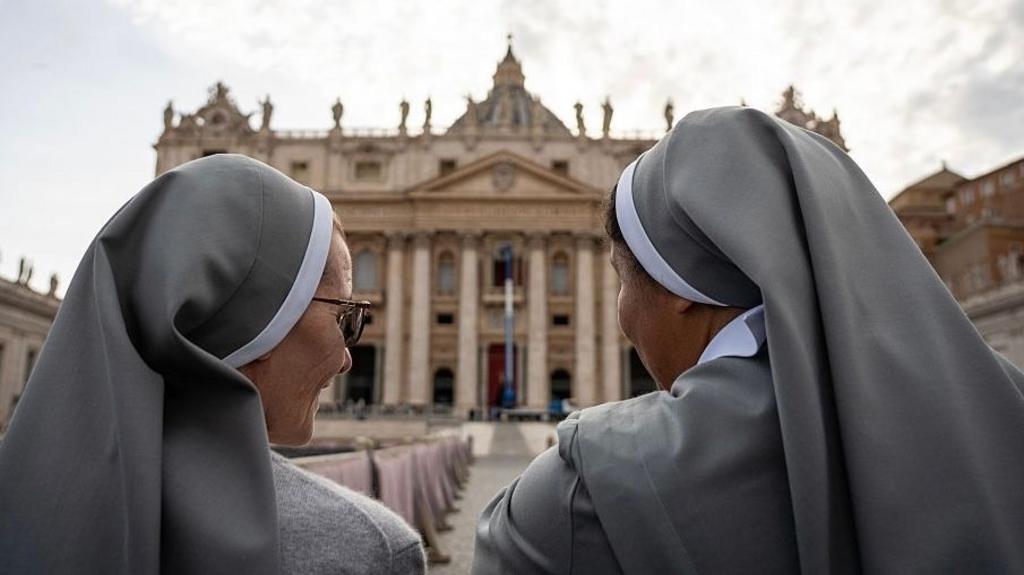After two days without a pontiff, St Peter’s Square became the setting for a moving scene as a group of nuns, dressed in grey habits, began to sing.
Initially their rendition of Ave Maria was barely audible, but their voices soon swelled, inviting others in the crowd to join in as they waited solemnly to pay their respects to Pope Francis lying in state.
Slowly keeping pace with the line, the nuns in white veils and wide-brimmed hats continued their hymn, gazing towards the imposing basilica as sunlight danced off their attire.
Such scenes underscored a remarkable week in which Rome appeared to reclaim its distinction as the “capital of the world,” with St Peter’s Square reaffirmed at the heart of global Catholicism.
While mourning for the 88-year-old Pope is palpable, his swift and peaceful passing is a solace for many. “At least he did not suffer,” has become a common sentiment. This period, however, is far from festive—those moments are reserved for after the funeral, when the conclave ushers in anticipation, speculation, and intrigue.
For now, Rome inhabits a unique interlude, distinct in atmosphere and tone.
Elena, a Romanian in her 50s, reflected on a contemplative mood pervading the city. “The crowds are large, yet everything feels subdued, different,” she told the BBC, suggesting that the Pope’s passing has encouraged deeper introspection among residents.
She also noted that even those without religious faith seemed moved by his death in some way.
Her friend Lina, serving customers in her Borgo Pio tobacconist—a street known for its ochre buildings and flower-laden windows—agreed. “This is neither a time of tragedy nor of celebration,” she said. “It is an opportunity for reflection, something truly needed.”
Nearby on Via della Conciliazione, pilgrims strolled down the avenue linking Italy and the Vatican—following the path along which the Pope’s coffin will journey to its final resting place at Santa Maria Maggiore basilica on Saturday.
Though little more than four kilometres separate the 4th-century church from St Peter’s, the procession is expected to last two hours, the Vatican announced, allowing crowds ample time to say farewell along the route.
Two plainclothes officers noted that the area was busier than usual but retained a relaxed Saturday-like feel.
Nonetheless, the magnitude of the security measures enforced by both Vatican and Italian authorities was self-evident.
On Wednesday, a soldier stationed outside a religious supply store was seen holding a large anti-drone device, while a companion scanned the sky with binoculars. During the funeral, thousands of security specialists—including river patrols, bomb squads, sniffer dogs, and rooftop marksmen—will be deployed.
Caislyn, a 21-year-old American student sketching St Peter’s dome, expressed surprise at how secure she felt amid the throngs.
She attributed the peaceful mood to the nature of the gathering: “People are here to honour Francis and to appreciate this remarkable city.” Describing the occasion as “bittersweet,” she ultimately saw the funeral as a “celebration of life.”
“He set a profound example for the world,” she recalled.
As Caislyn remembered Francis’ focus on the marginalized, others highlighted his final known outing: a Maundy Thursday visit to prisoners at Regina Coeli jail, one of his many such acts.
“He was close to the people,” Elena said, explaining her empathy for his commitment. “I volunteer for the homeless, and every time I want to stop, something draws me back. I’ve lived in poverty, so I relate.”
“I believe Francis felt the same,” she added, referencing memories shared by Francis’s sister Maria Elena about their impoverished upbringing in Argentina.
“He never lost touch with his origins. Even upon ascending to the highest office, he remained unchanged.”
Dirk, a Belgian tourist whose wife queued to see the Pope, remarked that the solemnity had a magnetic effect: “It’s a moment people want to witness—even if, perhaps, it’s only fleeting.”
With wry humour, he speculated on the temporary nature of the mood.
Dirk also pointedly observed the stark disparity around the Vatican: “I saw a woman, hunched over, ignored by passing clergy. It is striking—the opulence of the churches against the poverty outside their doors.”
“The contrast is truly arresting,” he concluded.
Katleho, a young woman from Lesotho, shared with the BBC the joy she felt upon receiving the Pope’s Easter blessing just before his death. “It made me feel special, truly part of the Catholic community,” she said, delighted to be among those honoring Francis in person.
“It’s a wonderful shared experience,” she said, before hurrying back to her group.
During three days of public viewing, tens of thousands converged on St Peter’s to offer their final farewells to the Argentine Pope who famously declared he came “from the ends of the earth.”
Father Ramez Twal of Jerusalem was the last pilgrim allowed in line to view Francis’s body.
“For us from the Holy Land, saying goodbye is deeply emotional,” he explained.
“He supported us throughout difficult times; his spiritual guidance and compassion were invaluable. We will truly miss him.”
As visitors and pilgrims entered the basilica after long waits, they approached Francis’s casket beside St Peter’s high altar. Some raised smartphones for photos, others clung to rosaries or the hands of their children, all maintaining a reverent hush.
Outside, under gentle April sunshine, groups of African pilgrims in bold headdresses enjoyed gelato near the Bernini fountain while seagulls soared overhead.
Retirees from California cooled themselves in the colonnades, and journalists from across the globe pursued cardinals possibly eligible for the upcoming conclave.
A Brazilian priest spun his phone to offer those at home views of the thronged square, laughing as he spoke.
The Bishop of Portsmouth remarked on Pope Francis’s innate humanity in his tribute.
The Vatican’s envoy to South Sudan encouraged others to honour Francis’s legacy by pursuing peace.
Michelle O’Neill described the late Pope as “a man of humility.”
Numerous global leaders and royalty are in attendance among the mourners—see images from these moments here.
First Minister John Swinney is among those from Scotland travelling to Rome for the Pope’s final rites.

